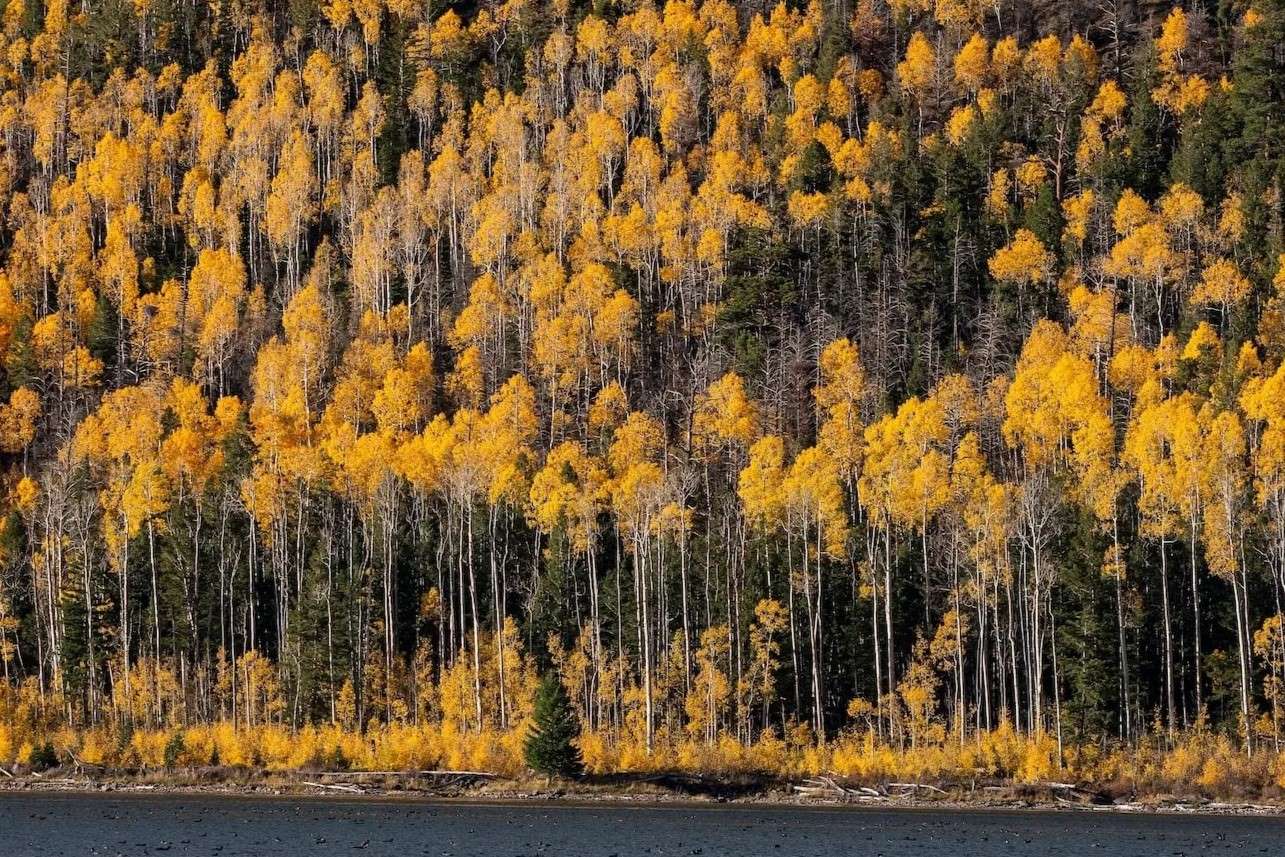
Did you know that the world's largest living organism isn't an animal, but a tree? Meet Pando, also known as "The Trembling Giant," a massive clonal colony of quaking aspen trees located in Utah's Fishlake National Forest. Spanning over 106 acres and weighing around 13.2 million pounds, Pando is a single organism connected by an extensive root system. This ancient marvel could be up to 80,000 years old, predating human settlement in North America. Despite its resilience, Pando faces threats like overgrazing, drought, and fire suppression. Conservation efforts are crucial to ensure this natural wonder continues to thrive for future generations.
Key Takeaways:
- Pando, also known as "The Trembling Giant," is the world's largest living organism, weighing around 6,000 metric tons and spanning over 106 acres in Utah, USA.
- Pando's survival is threatened by overgrazing, drought, and fire suppression, but conservation efforts and community involvement are crucial for protecting this natural wonder.
Pando: The Trembling Giant
Pando, also known as "The Trembling Giant," is a natural marvel that has fascinated scientists and nature lovers alike. This unique organism is not just any tree; it is the world's largest living organism by both weight and landmass. Let's explore some incredible facts about Pando.
Location and Habitat
Pando's home is in the Fishlake National Forest in Utah, USA. This area provides the perfect environment for this giant organism to thrive.
- Pando is located in the Fremont River Ranger District of south-central Utah, covering about 108 acres (43.6 hectares).
- It is situated approximately 1 mile (1.6 kilometers) southwest of Fish Lake.
Name and Meaning
The name "Pando" carries a special significance that reflects its unique nature.
- "Pando" comes from the Latin word "pando," meaning "I spread," which describes its ability to spread its roots and produce new stems.
Scientific Classification
Understanding Pando's scientific background helps us appreciate its uniqueness.
- Pando is a male quaking aspen (Populus tremuloides), known for its quivering leaves when the wind blows.
Size and Weight
Pando's size and weight are truly astonishing, making it the heaviest known organism on Earth.
- Pando is estimated to weigh around 6,000 metric tons (6,600 short tons) or 13.2 million pounds.
- It spans over 106 acres (43.6 hectares), making it the largest tree by landmass.
Number of Stems
Pando's structure is composed of numerous stems that appear as individual trees but are all part of the same organism.
- Pando features an estimated 47,000 stems, all genetically identical and connected by a massive root system.
Root System
The root system of Pando is ancient and extensive, playing a crucial role in its survival.
- The root system spans several thousand years old, with some estimates suggesting it could be as old as 14,000 years.
Stem Lifespan
Individual stems of Pando have a limited lifespan, but the organism continues to thrive through regeneration.
- Stems typically do not live beyond 100–130 years, but new stems constantly replace the old ones.
Regeneration Process
Pando's ability to regenerate ensures its continued growth and survival.
- Pando regenerates through "suckering," where new stems emerge from the roots.
Genetic Identity
Pando's stems are all genetically identical, making it a single clonal organism.
- Each stem is genetically identical to the others, forming one massive organism.
Historical Discovery
The discovery of Pando as a single living organism was a significant milestone in botanical research.
- Pando was first identified as a single organism in 1976 by botanists Burton Barnes and Jerry Kemperman.
Recognition and Commemoration
Pando has been recognized and celebrated for its unique characteristics.
- In 2006, the U.S. Postal Service honored Pando with a commemorative stamp as one of the "40 Wonders of America."
Age Estimates
The age of Pando is a topic of ongoing debate among scientists.
- Some estimates suggest Pando could be as old as 80,000 years, while others speculate it may be up to 1 million years old.
Historical Context
Pando's age predates human settlement in North America, making it a living witness to history.
- Pando would have been at least 50,000 years old before humans arrived in North America.
Geological Factors
The geological conditions of the area have contributed to Pando's growth and survival.
- The unique geological conditions, including a spreading fault zone and rich soil from glaciers, provided an ideal environment for Pando.
Climate Adaptation
Pando has adapted to the arid climate of the Western United States, allowing it to thrive where other trees might struggle.
- The arid climate has favored clonal reproduction in aspens like Pando.
Ecological Importance
Pando plays a crucial role in its environment, supporting local wildlife and maintaining biodiversity.
- Pando helps keep the soil in place, supports local wildlife, and adds to the area’s biodiversity.
Conservation Efforts
Efforts are being made to protect Pando from various threats.
- Conservationists are working to protect Pando by installing fencing and implementing controlled grazing plans.
Threats to Pando
Pando faces several threats that could hinder its ability to regenerate and sustain itself.
- Overgrazing by deer and elk, drought, and fire suppression are significant threats to Pando.
Historical Management
Historically, predators helped regulate herbivore populations, but their decline has impacted Pando.
- The decline of wolves and cougars has led to an increase in grazing animals, further threatening Pando.
Current Management
Efforts are being made to manage grazing and protect Pando.
- In 2023, local grazers group 7 Mile Grazers implemented a controlled grazing plan to protect Pando.
Biodiversity Role
Aspen trees like Pando provide natural fire breaks, making them crucial for maintaining forest health.
- Aspens have high water content and do not burn readily, helping to maintain forest health.
Unique Characteristics
Pando's stems have unique characteristics that contribute to its survival.
- Each stem can reach heights of up to 80 feet tall, 3 feet wide, and spread up to 30 feet at the top.
Local Significance
Aspen trees hold a special place in the hearts of Utah locals.
- Utah locals refer to aspen trees as "quakies" due to their distinctive quivering leaves.
Cultural Significance
Aspen trees have cultural significance and are surrounded by legends.
- Some legends suggest that the "eyes" of aspen trees watch over children. These "eyes" are actually branch scars.
Co-Habitants
Pando shares its home with various wildlife species.
- Wildlife such as black bears, red foxes, mountain lions, rocky mountain elk, and mule deer live in Pando's habitat.
Age Limitations
Individual stems of Pando have a limited lifespan, but the organism continues to thrive through regeneration.
- Each stem can live up to 120-150 years, but typically do not live beyond 100–130 years.
Fencing and Protection
Efforts are being made to protect Pando from over-browsing by deer and elk.
- The US Forest Service and volunteers have installed fencing around 53 acres of Pando.
Future Uncertainty
Despite its historical resilience, Pando's future is uncertain due to ongoing threats.
- Pando's future is uncertain due to ongoing management issues and uncontrolled foraging by wild and domestic animals.
Scientific Study
Researchers are studying Pando to understand its unique longevity and how it has sustained itself over thousands of years.
- This knowledge can help protect other natural marvels.
Paleo-Climate Models
Paleo-climate models provide insights into Pando's age and survival.
- A 2017 paper suggests that Pando could not be older than the last Glacial Maximum based on paleo-climate models.
Environmental Factors
Pando's long-lived nature suggests it has survived various environmental challenges.
- Pando has survived droughts that have driven out humans for centuries, but current environmental factors pose significant threats.
Management Strategies
Conservation efforts focus on mitigating threats to ensure Pando's continued survival.
- Efforts include restricting herbivore access, implementing controlled grazing plans, and ensuring Pando's health.
Community Involvement
Local communities and conservation groups are actively involved in protecting Pando.
- Educational programs and community outreach raise awareness about the importance of preserving this natural wonder.
Pando's Legacy and Importance
Pando, the world's largest living organism, stands as a testament to nature's resilience and interconnectedness. Spanning over 106 acres in Utah's Fishlake National Forest, this clonal quaking aspen has survived for thousands of years, possibly up to 80,000. Its unique ability to regenerate through suckering ensures its continued existence, despite individual stems living only about 100-130 years. However, Pando faces threats from overgrazing, drought, and fire suppression. Conservation efforts, like fencing and controlled grazing, aim to protect this natural wonder. Pando's significance extends beyond its size and age; it plays a crucial role in its ecosystem, supporting wildlife and maintaining soil health. Understanding and preserving Pando can offer valuable insights into the conservation of other natural marvels. This remarkable organism reminds us of our duty to protect and sustain the planet's unique wonders for future generations.
Frequently Asked Questions
Was this page helpful?
Our commitment to delivering trustworthy and engaging content is at the heart of what we do. Each fact on our site is contributed by real users like you, bringing a wealth of diverse insights and information. To ensure the highest standards of accuracy and reliability, our dedicated editors meticulously review each submission. This process guarantees that the facts we share are not only fascinating but also credible. Trust in our commitment to quality and authenticity as you explore and learn with us.


